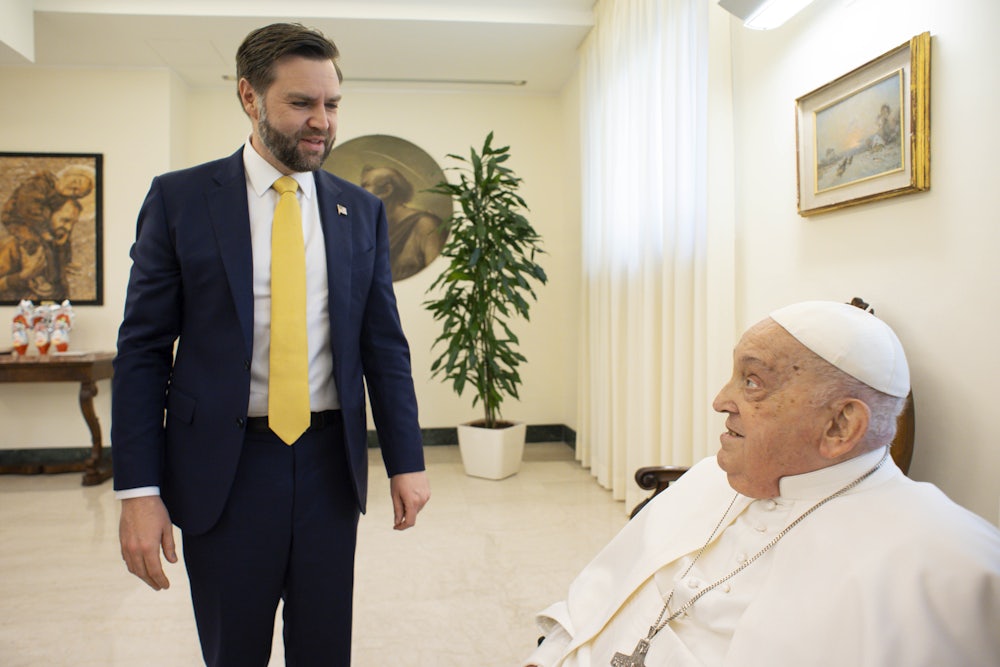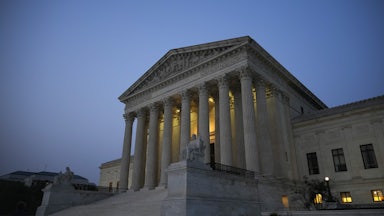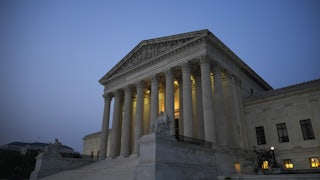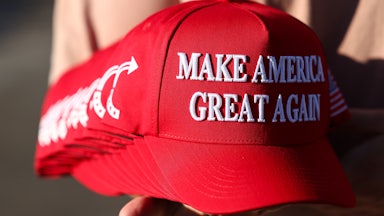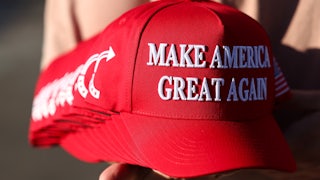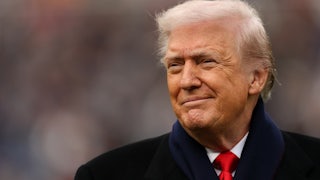It was disconcerting to watch JD Vance being received by the ailing Pope Francis at the Vatican this past Easter. The pope, like a character in a cheap airport thriller, had 24 hours to live. And Vance, an only recently converted Catholic, struck many other Catholics as a born-again Christian nationalist in Catholic garb—as he misread the Catholic teaching of ordo amoris to justify cruelty to migrants, then tormented the president of Ukraine in an Oval Office struggle session where Yale law sophistry met with good ol’ hillbilly thuggery.
It was all this and the fact of Vance as an opportunist so calculating he must have known that, at the moment of Francis’s death, he’d be the most powerful Catholic in the world—a fact speaking to how, over the last quarter-century, Protestant America (O, Appalachian snake handlers; O, UFC cathedrals; O, City on a Thrill) had achieved a spiritual collapse so staggering as to affect even the Church of Rome.
After his presidency, George W. Bush began painting portraits of American men and women who had been dismembered in his wars. It was touching, perverse, sincere, this attempted self-exorcism. He painted and he painted, making icons of the victims of his own crimes, wars that Bush—a born-again cowboy of Puritan ancestry—had tried selling to the French president, Jacques Chirac, in messianic terms: He said that two demons, Gog and Magog, were at work in the Middle East, where soon a new age would dawn.
Bush was right about the new age, but sloppy on geography.
The response to 9/11 was a wave of government spending and borrowing to prop up the economy and finance conflicts costing approximately $8 trillion. This was just a warm-up act for the 2008 financial crisis, after which trillions were injected into the economy to bail out Wall Street. Money, Bush might have learned from his father, doesn’t trickle down; it gathers to itself. Occupy Wall Street protested emerging oligarchy, but their camp at Zuccotti Park was cleared out by Michael Bloomberg, a financial services billionaire. America’s rich were not chastened, but emboldened, by the 2008 crash, and they got away with it.
Money wasn’t up for discussion, and as the printing of easy dollars continued under Obama, inequality soared and culture turned brutal. There was division along every axis, accelerated by data mining, screens, and algorithms. Soon there were two antagonistic poles that held each other beyond redemption. On the left, some unfortunate soul recalled a word, woke, from the Civil Rights days, as a call for vigilance amid injustice. The right was merciless, hammering “wokeness” as a secular religion. The left, in turn, taunted MAGA as a death cult whose members had mistaken a living Cheeto for the Hale-Bopp comet. In reaching for sectarian terms, neither side was wrong. The demons Gog and Magog didn’t materialize in the Middle East, but after the desert wars two equally dangerous religious forces emerged at home: founding strains of American Protestantism that, once bizarrely contained in the person of George W. Bush, now began fighting across society.
In 1632, the first Bush sailed from England and settled in Plymouth with other Puritan zealots who had the misfortune of believing that only a handful of souls would ever go to heaven, and humanity was irretrievably fallen.
In Albion’s Seed, a survey of founding American folkways and how they still define us, David Hackett Fischer describes the consequences of this grim view—endless purification and joyless theocracy. They frowned on bright colors. A Puritan church’s only adornment would be an eye painted on the pulpit, its surveilling gaze extending to the bedroom. Unable to accept human nature, they obsessed over bestiality, once admitting a deformed piglet as a witness in order to convict and hang the man suspected of fathering it. When another piglet was born “with one red eye and what appeared to be a penis growing out of its head” it was all too much; “the magistrates compelled everyone in town to view it in hopes of catching the malefactor.”
Wealth was a divine reward for God alone to give.
Speculators and profiteers were fined, shamed, and exiled. The manipulations that caused the 2008 crash and inequality that followed would have been as offensive to these people as it was to their contemporary heirs at universities like Yale and Harvard, former Puritan seminaries where people now longed for cultural purification. To deconstruct gender, to root out structural racism and toxic masculinity, to decolonize fitness (even wellness was unwell, in late America) and maybe even purify America’s own essential invention: whiteness itself. To find, at long last, the pig-fucker.
Here was a last-ditch effort at imposing morality on a runaway capitalism. With the legislature broken, it was necessarily illiberal, sometimes running into the 1964 Civil Rights Act. In fullest form, it operated through institutional departments of diversity, equity, and inclusion, the Puritan streak so ingrained that even the movement’s most educated maybe didn’t realize that of all acronyms, the one they’d chosen—DEI—was Latin for from God. All of this meant incredibly well, and was bound to torment the other America line embodied in Bush—the royalist planters of Virginia.
As Puritans denounced speculators in seventeenth-century Massachusetts, another group of English Protestants were busy devising ways to extract as much as possible from the land itself and other human bodies. These were the royalist Anglicans of Virginia, whose system of race slavery and native dispossession would find its way west to Texas. Their world was vicious from the start, with cannibalism in the early years, and mortality rates between 40 and 60 percent.
They had recently rebelled against the pope of Rome, declaring the English monarch a semi-sacred figure from whom oligarchy flowed as an extension of divine right. Bigoted and land-hungry, they mounted an insurrection when the colonial governor refused to dispossess Native Americans, igniting Bacon’s Rebellion, which sent the governor fleeing to England as Jamestown was torched—it turns out that after breaking with a pope in Rome, sacking a local governor is easy. Men took many mistresses and raped their slaves; and even the women, writes Hackett, horrified visitors by “carefully examining” the genitals of enslaved men at the market where lives were sold.
It’s no surprise that the nativists who ignored Trump’s sexual assaults then attacked the U.S. Capitol to cement his rule and the culturally purifying left would end up fighting over the future of the Puritans’ most enduring institution, Harvard University, which didn’t just raise $750 million in debt to defend itself against Trump from any lack of real existential peril. What no one saw coming was that somewhere across years of this essentially sectarian conflict, the American Catholic Church, still reeling from endemic molestations and cover-ups, began looking good by comparison.
It had a new pope, in Francis, who dedicated himself to two things that warring Americas didn’t value very highly: mercy and contrition. He acknowledged the horrors of clergy abuse and apologized to Canada’s First Peoples for forced assimilation and cultural destruction. Asked if there was a place for gays in the church, he said, “If a person is gay and seeks God and has good will, who am I to judge?” The Catholic position against abortion is unchangeable, a long-running reaction to imperial Roman bloodlust and infanticide. Still, Francis preached compassion to women receiving abortions, and more importantly, forgiveness. Modest? Maybe, but compared to the bleakness of victim/victimizer dialectics—it was human, even hopeful.
Then came another twist.
As American despair deepened, born-agains started converting to Catholicism. These are the people whose grandfathers
might have agreed with the charges that Protestant nativists loudly leveled
against John F. Kennedy—that a Catholic in high office would have to take
orders from the pope in Rome, i.e., could never be a real American. They could
never have imagined that the Catholic in question might be a JD Vance or that the pope would be a guy from Chicago.
Pope Leo was born Robert Prevost in a humble home on the South Side of the city.
He attended a seminary high school and then Villanova, founded by Irish Augustinian friars in Philadelphia, a school whose institutional memory might have prepared him for the America to come; it was briefly closed after nativist riots in 1844. He joined the Augustinians after graduating, then spent a decade with their mission to Peru, a country to which he returned in 2014, sent back by the ailing Pope Francis. He notably said nothing of America or Chicago in his first speech, but spoke directly to “my dear diocese of Chiclayo, in Peru.”
The man Americans were celebrating as their first pope seemed, along the way, to have become spiritually, well, Latin American—a fact that might have challenged Americans dug into rigid identity binaries. It was celebrated by the Peruvians themselves, and the phenomenon of Leo’s absorption of multiple cultural identities makes perfect sense to a well-travelled Catholic, who knows how the church changes across cultures, making good on its name—“All-Embracing.”
And it wasn’t lost on the Argentine Pope Francis when he made Prevost a Peruvian bishop in 2014, thus requiring him to gain Peruvian citizenship. Or in 2023, when he made him a cardinal and called him to Rome, thus creating that most rare and alluring of papal candidates: a pope from both Americas with a Vatican mailing address. A successor.
We now know that, in the meeting of Vance and Francis, the ailing man held the stronger hand: the creation of an “American” pope from Peru. One whose presence not only insulates the Catholic faith from America’s right wing, her spiritual meltdown, but also, in an act of sage tenderness, offers aspects of the faith that Francis practiced so beautifully: a radical challenge, of mercy, of compassion that, given Leo’s youth, could last a decade or more, carried out under a name chosen to honor its previous holder, Leo XIII, who in his encyclical of the first Gilded Age, 1891’s Rerum Novarum, famously spoke of the eternal duty of the rich to the poor, of capital to labor, and of the machine to the spirit.* What is there to say of this, in the spring, weeks after Easter, amid the miracle of flowers? There are lines from psalms that only gain in meaning with repetition, revealing depths of wisdom and renewal: “This is the day the Lord has made, let us rejoice and be glad in it” (Psalms 118:24).
* This post originally misidentified the author of the Rerum Novarum.
